Making a daily to-do list might help you prioritize your goals and arrange your work. You may keep track of what has to be done and make sure you don't overlook any critical activities by using a to-do list.
You may increase your productivity and experience a feeling of success as you cross things off your to-do list throughout the day by segmenting your work into smaller, more manageable pieces. We'll go through how to make a productive daily to-do list in this tutorial, along with some advice on how to follow it.
You can download your to do list template by clicking the cover image.
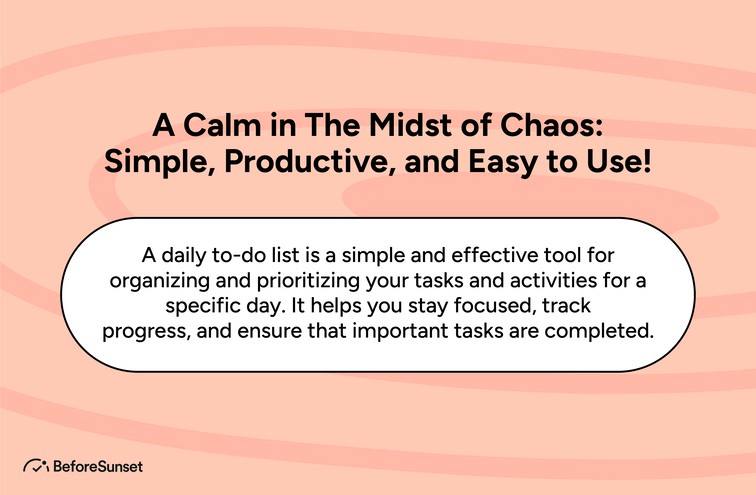
A Calm in The Midst of Chaos: Simple, Productive, and Easy to Use!
Having a calm and organized approach to tasks can be especially helpful in the midst of chaos, and a simple, productive, and easy-to-use to-do list can help achieve this. It's important to keep the to-do list simple and focused on the most important tasks.
Using a clear and concise format, such as bullet points or short phrases, will make the list visually appealing and easy to read. Being specific about each task and including deadlines or target dates can also be beneficial.
Utilizing a task management app or virtual assistant can aid in organizing and prioritizing the list and provide reminders and alerts to stay on track. Regularly reviewing your to-do lists and making adjustments as necessary will ensure progress is being made and the list remains relevant.
A calm and organized to-do list can help maintain productivity and reduce stress, even in the midst of chaos.
First Thing First: Say Goodbye to the Written To-Do List
Written to-do lists are no more! You can organize your chores and schedule more effectively now that there are a lot of digital options available thanks to the development of technology.
To manage your non-written to-do list and create reminders for crucial chores, for instance, you may use a task management software, project management tool or a virtual assistant. Additionally, you may use these tools to arrange your calendar and prioritize your duties, which will make it simpler for you to remain on top of your workload and accomplish your objectives. Online to-do list apps are here to make organizing daily tasks a breeze.
What is the Psychology Behind To-Do Lists?
A common tool for efficiently arranging work and managing time is the to-do list. There are various things that may be used to explain the psychology of to-do lists:
External memory aid: To-do lists act as an external memory assist by allowing us to transfer mental chores on paper or a digital platform. We free up brain space and lessen the cognitive burden needed to recall everything we need to complete by writing down our duties.
Cognitive offloading: The human brain has a certain amount of working memory, which has an impact on our capability to concurrently retain and process information. To-do lists serve as an external storage system that relieves us of the strain of remembering chores so that we may concentrate on carrying them out.
Goal activation: Making a to-do list of chores aids in igniting our intents and objectives. We are more likely to complete our chores when we can physically or visually see them in a list style. Our drive and feeling of purpose are increased since it gives us a concrete reminder of what has to be done.
Organization and setting priorities: We may prioritize our duties and create a feeling of order with the use of to-do lists. We may better grasp what has to be done first by setting priorities, deadlines, or categorizing jobs according to their urgency or significance, which reduces confusion and increases productivity.
Sense of control: Making to-do lists might help us feel in control of our workload and less overwhelmed. We see activities as tangible and doable when they are written down as opposed to abstract and intimidating. This sense of control can reduce stress and improve our capacity to approach things with assurance.
Completion bias and satisfaction: A sensation of success is evoked when things are crossed off or crossed out on a to-do list. This is known as completion bias. Dopamine is released in the brain as a result of this sense of accomplishment and development, and this positive feedback loop encourages us to carry out more tasks. Aside from lowering anxiety, seeing projects through to completion enhances general wellbeing.
Planning and visualizing: To-do lists provide our duties a visual representation, which helps us schedule our time wisely. We may evaluate the workload, spot any gaps or conflicts by looking at the tasks in order, and then adapt as necessary. By assisting with mental planning, visualization enables more effective time and resource management.
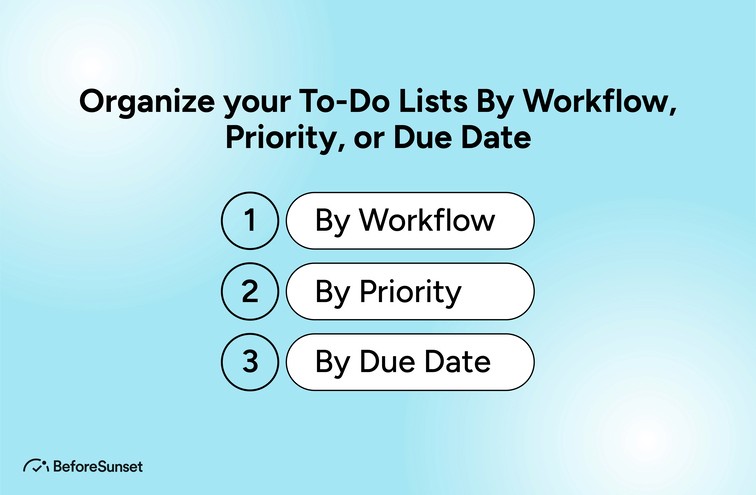
Organize your To-Do Lists By Workflow, Priority, or Due Date
Keeping yourself on track and achieving your goals requires the organization of your to-do list. Your to-do list can be arranged in a variety of ways, such as by process, priority, or due date.
Grouping similar tasks together and doing them in order is organized by workflow. This might assist you in getting a better sense of the overall picture and the stages necessary to finish a job.
Prioritize tasks to make finishing your to do's easier. This can assist you in focusing on what matters most and prevent you from spending time on activities that can wait.
Organizing by due date entails setting up your assignments according to their due dates. This can assist you in staying on top of your due dates and preventing last-minute scrambles to finish things.
The technique you use will ultimately be determined by your own tastes and the nature of your duties. Additionally, you could discover that adopting a mix of these techniques is most effective for you.
Prioritize Your To-Dos
Prioritizing your to-dos is a crucial step in managing your tasks and staying on track. The first step in prioritizing your to-dos is to identify your goals and understand what you want to achieve.
Evaluating the urgency and importance of each task is also essential. Tasks that are both urgent and important should be given higher priority.
The Eisenhower Matrix can be a helpful tool in this process, dividing tasks into four categories based on their urgency and importance. Writing down all the tasks you need to complete and prioritizing them based on these criteria will allow you to focus on what is most important and avoid wasting time on low-priority tasks.
It is also important to regularly review and adjust your to-do list to make sure you are still on track, as new tasks may arise and priorities may change. By prioritizing your to-dos, you can achieve your goals more efficiently and effectively.
Break Big Work Into Smaller Tasks
Breaking up major chores into smaller ones is one of the most effective strategies to create to-do lists that really get done. This method simplifies the work and provides a clear path to completion, which aids in overcoming the problems associated with large, complex projects.
When a major project is broken into smaller jobs, it is easier to analyze progress, prioritize activities based on urgency and relevancy, and establish adaptive plans.
This allows you to keep your focus, drive, and sense of direction throughout the project's completion phase. Making an efficient to-do list necessitates dividing down huge tasks into smaller ones. To reach your goals, it is critical that you focus on one action at a time.
Always Include a Deadline
Including deadlines in your to-do list is a critical step toward meeting your objectives and being productive. Deadlines promote motivation, assist with time management, facilitate goal formulation, and improve organization.
When you assign a precise date or time to each activity, you are more likely to prioritize and complete it on time. This can help you remain on schedule, minimize procrastination, and make better use of your time.
Deadlines may also be used to track progress and keep oneself accountable for finishing tasks. Incorporating deadlines into your to-do list will help you keep organized and motivated while also ensuring that you are progressing toward your goals.
Make a point of including deadlines in your to-do list to help you stay productive and reach your goals.
Advantages and Disadvantages of Making a To Do List
To-do lists are becoming a common tool for task management and increasing productivity, becoming an essential part of many people's life. These lists have several benefits that keep people motivated, focused, and organized. Like every instrument, there are drawbacks to take into account.
In this section, we will examine the benefits and drawbacks of creating a to-do list, providing information on both the possible advantages and drawbacks of this tool. People may decide how to best integrate to-do lists into their daily routines and maximize their efficacy by being aware of all sides of the argument.
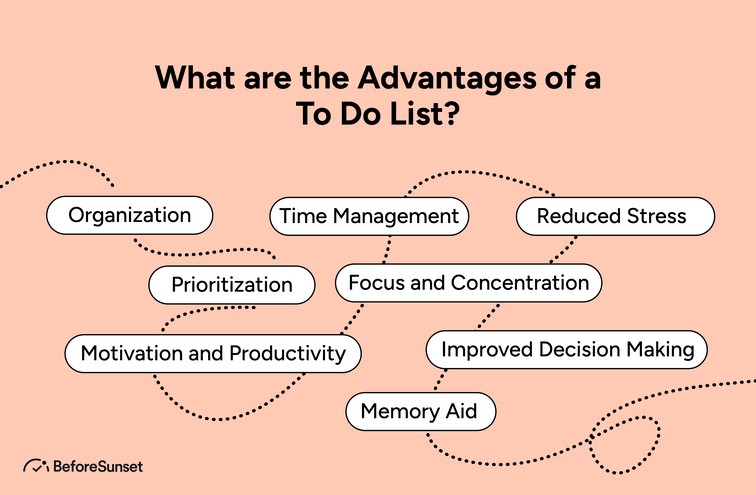
What are the Advantages of a To Do List?
A simple yet effective tool, a to-do list may greatly improve productivity, time management, and general well-being. To-do lists include a number of benefits that assist people in staying organized, prioritizing tasks correctly, and achieving their goals. We will talk about the benefits of utilizing a to-do list in this conversation, emphasizing how it may make our everyday life more organized, clear, and satisfying. Understanding the advantages of a to-do list may enable you to optimize your productivity and find balance in the middle of a hectic schedule, whether you're a student, a professional, or someone juggling several duties.
1. Task organization:
The ability to organize tasks is a key benefit of to-do lists. In our busy lives, it's simple for duties to get dispersed, overlooked, or overrun by their sheer volume. The format of a to-do list gives you a location to compile and arrange all of your chores. Making a list of your responsibilities allows you to organize them into a single location, which helps to keep crucial work from being lost in the shuffle.
Writing down activities aids in memory retention and provides a visual representation of the size and complexity of your assignment. The ability to grasp the overall picture of what needs to be done makes it simpler to set priorities and efficiently use your time and resources.
2. Prioritization:
One of the main benefits of having a to-do list is prioritization. It's critical to recognize and concentrate on the most crucial and urgent jobs because there are many tasks fighting for our attention. You may prioritize your chores using a to-do list, which will help you use your time and resources wisely.
You may determine what has to be done first by arranging jobs according to significance or urgency. This makes it easier for you to tackle high-priority chores quickly and prevents you from becoming overburdened by a big list of tasks. You may focus your efforts on projects that will have the most influence on your goals or that have upcoming deadlines by prioritizing them.
3. Time management:
A major benefit of using a to-do list is time management. In today's hectic environment, when expectations and duties may easily overwhelm us, effective time management and allocation are essential. A to-do list is an effective tool for increasing productivity and time management.
You may arrange your day or week using a to-do list by designating particular time intervals for certain chores. You may better grasp how to allocate your time by dividing projects down into smaller pieces and evaluating how much time is needed for each. This helps you avoid overcommitting or ignoring crucial obligations and avoids activities from lasting longer than they should.
4. Increased productivity:
The use of a to-do list has the significant benefit of increasing productivity. Finding methods to do more in less time is essential in our time-constrained existence, and a to-do list may be an effective tool for doing so.
Your tasks and obligations are clearly outlined through to-do lists. You may prioritize activities wisely, prevent forgetting to do them, and maintain focus on your objectives by having a visual depiction of everything that has to be done. Productivity is raised as a result of this structure and clarity.
5. Reduced stress:
A to-do list can serve as an external memory help, which lowers stress. You no longer have to rely exclusively on your memory to remember everything when you jot down the things on your list. This information unloading creates mental space and lessens the cognitive burden needed to recall and balance several activities. As a consequence, you may feel relieved knowing that your responsibilities are recorded and are available for reference at any time.
6. Motivation and focus:
A to-do list has several benefits, including increasing motivation and focusing attention. A to-do list is an effective tool for sparking inspiration, retaining focus, and accelerating goal-achieving.
You are essentially establishing clear intents and goals for yourself when you make a to-do list. When you write down tasks and see them in front of you, your subconscious mind is activated and is reminded of what you want to do. By giving people a feeling of direction and purpose, this method encourages motivation. You are more likely to feel inspired and dedicated to acting if you visualize your chores and goals.
7. Improved organization and efficiency:
Task management may be consolidated and managed with the use of to-do lists. You may establish a systematic and convenient record of what needs to be done by noting your chores on a list. As a result, there is no need to rely on memory, and duties are kept from becoming overlooked. Your ability to prioritize activities effectively, distribute resources effectively, and schedule your time more wisely depends on having a clear and structured perspective of your responsibilities.
8. Flexibility and adaptability:
The capacity to be flexible and adaptable is a key benefit of utilizing a to-do list. To-do lists are sometimes perceived as being inflexible and fixed, yet when used properly, they may really give a great lot of flexibility and adaptability.
A to-do list's capacity to account for changes and unforeseen circumstances is one of its advantages. Because life is unpredictable, priorities might change at any time. You may simply modify and alter your assignments with a to-do list in response to fresh knowledge or evolving situations. You may adjust your list if a new urgent activity comes up or a prior task loses importance. This will help you keep focused on what's most crucial right now.
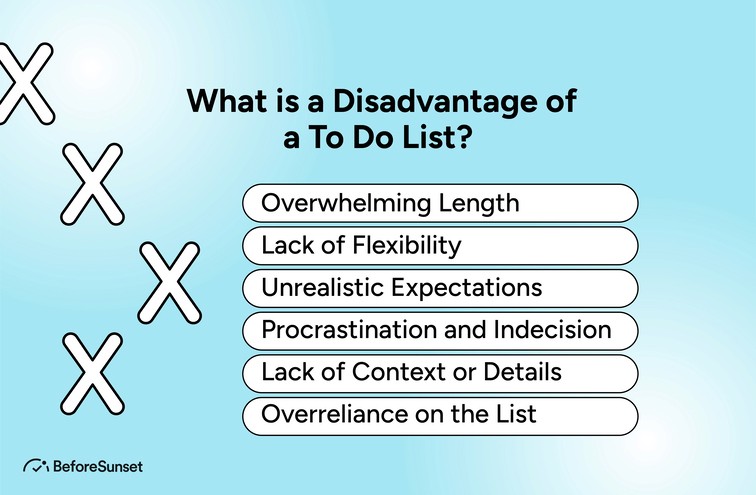
What is a Disadvantage of a To Do List?
A to-do list has the potential to become too dependent on it, which can lead to feeling overwhelmed by the sheer number of chores. While a to-do list may be a useful tool for productivity and organization, if the list grows too lengthy or if chores pile up more quickly than they can be finished, pressure and anxiety may result.
An unnecessarily extensive to-do list can be intimidating and demoralizing. Overwhelm brought on by the sheer volume of work might result in procrastination or a sensation of being unable to go forward. As a result, productivity may suffer and stress levels may rise, which defeats the point of creating a to-do list in the first place.
A to-do list may also not take into consideration the flexibility and unpredictability of some activities or outside variables. The timetable may be disrupted by unforeseen disruptions and crises, tasks that take longer than intended to finish, or both. If things on the to-do list are not completed within the anticipated timeframe, this can lead to dissatisfaction and a feeling of inadequacy.
The risk of concentrating primarily on task completion rather than the caliber of work or the wider picture is another possible drawback. People may prioritize quantity above quality when they are just concerned with crossing things off their to-do list, which can result in hurried or poor results. When performing duties that need for meticulous attention or original thought, this might be counterproductive.
A to-do list also runs the risk of making you overly stiff and unyielding. While structure and order are crucial, adhering too strictly to a to-do list may stifle creativity, spontaneity, and adaptation. The capacity to investigate novel concepts or respond to unforeseen opportunities or difficulties may be hampered by a concentration on finishing preset duties.
Finally, a lack of attention and a busy schedule might result from continually adding activities to a to-do list without sufficient prioritizing. The list can easily grow too long and impossible to complete if each task's relevance and urgency are not properly considered. As a result, one may have a sense of constant bustle without making any real progress toward key objectives.
What Should Be on a Daily To-Do List?
A thorough and well-organized list of the things that need to get done each day should be on your to-do list. It needs to cover a variety of obligations, both personal and professional, as well as anything else that needs consideration. Work-related chores like meetings, deadlines, and project-related work are some of the things that may be on a daily to-do list.
Personal obligations like exercising, doing errands, or spending time with loved ones have to be included on the list. Additional tasks like cleaning, laundry, and meal preparation should be included in the daily to-do list to guarantee a full and productive day.
Prioritize things according to significance and urgency to get the most out of your daily to-do list. You should also divide larger jobs into more manageable, smaller parts. You can remain on track and utilize your time more effectively by keeping an orderly daily to-do list.
Do People With ADHD Make To-Do Lists?
Yes, creating to-do lists is frequently beneficial for persons with ADHD (attention deficit hyperactivity disorder). To-do lists are a useful tool for managing time, prioritizing projects, and increasing productivity even if ADHD can make it difficult to keep organized and retain attention on tasks.
To-do lists provide chores a visual representation, which can aid people with ADHD in keeping a feeling of organization and direction. Focusing on one activity at a time is made simpler by breaking complex activities down into smaller, more manageable steps. A sense of motivation and achievement may also be gained by crossing accomplished tasks off a to-do list.

Is It Better To Make a To-Do List at Night or Morning?
Making a to-do list in the morning or at night relies on personal taste and what works best for each person. It ultimately boils down to which strategy best fits your productivity routine and style, as both have their benefits.
You may assess the things you performed throughout the day and make plans for the following day by making a to-do list at night. This might assist you in taking stock of your achievements and identifying any chores that still need to be completed. You may begin the morning with a clear plan of action by reflecting on your day and establishing goals for the next day. This strategy can help you feel mentally and physically ready, enabling you to get started right away when you wake up.
On the other hand, people who value a fresh start and wish to modify their priorities in light of the day's events may find it advantageous to make a to-do list first thing in the morning. You could be more aware of your energy levels, any important information that has emerged overnight, any pressing issues, and any necessary alterations to your schedule in the morning. You may adjust to the circumstances and establish priorities by making a to-do list in the morning.
Finding the time that promotes your productivity and works best for you is crucial in the end. You may test out both strategies to determine which makes you feel more focused and organized. By completing a short review of the day's responsibilities in the evening and then finishing it in the morning, some people may find it beneficial to mix components of both strategies.
No matter when you make your to-do list, it's crucial to make sure that it's reasonable, practical, and in line with your priorities. Maintaining flexibility and adaptability to unforeseen events or new priorities that may develop can also be helped by periodically checking and modifying your list during the day.
Finding a pattern that enables you to begin each day with clarity and purpose can help you achieve your objectives and enhance your productivity.
How Do I Organize My Daily Tasks at Home?
Your ability to focus, be productive, and feel in control of your duties may all be improved by organizing your everyday household activities. Here are some actions you may take to arrange your everyday duties efficiently:
Start with a Brain Dump: List all the chores that come to mind as you begin. You may record everything you need to accomplish with this brain dump, making sure nothing is missed.
Prioritize Tasks: Prioritize your chores based on priority and urgency after you have your list. Decide which jobs can wait until later in the day and which ones require immediate attention.
Break Down Tasks: Larger or more difficult jobs should be divided into smaller, more manageable segments. By doing so, they become less intimidating and you may go on without being discouraged.
Establish a Schedule: Based on the importance of your work and your availability, assign them to certain time windows. Plan your day around your energy levels and schedule the most difficult or demanding chores for when you're most productive.
Use Time Blocks: Use time blocking to allocate particular time blocks to particular kinds of jobs. You may, for instance, set aside a block for personal work, a block for leisure activities, and a block for domestic chores.
Realistic Expectations: Be careful to hold oneself to reasonable standards. It's best to avoid packing your calendar with too many things since failing to do them all might cause tension and a sense of failure. Be honest with yourself about how much you can get done in a day.
Use Apps and Tools: If you need assistance organizing your chores, think about utilizing either physical or digital tools. You can create and manage your to-do lists with the help of a variety of task management tools and applications.
Review and Reflection: At the conclusion of each day, spend a few minutes reviewing the things you've finished, evaluating your productivity, and making any required improvements for the next. With the aid of this reflection, you can assess your progress and spot any trends or modifications that might help you be more organized every day.

Should You Make a To-Do List Everyday?
A daily to-do list may be a very efficient approach to keeping organized, managing your time, and accomplishing your personal and professional objectives. Making a daily to-do list is a beneficial habit to get into for a number of reasons:
Increasing productivity: Keeping yourself focused and motivated is much easier when you have a list of things to perform.
Enhances time management: By allowing you to prioritize things and allot time accordingly, a daily to-do list can help you manage your time more successfully.
Improves organization: A well-structured to-do list can help you be more organized overall by making it simpler to monitor your progress and stay on top of deadlines.
Reduces stress: Having a list of chores that are clearly defined might help you feel more in charge of your day and less stressed out by giving you a feeling of direction and control.
How Many Things Are on The Daily To-Do List?
Depending on personal requirements and interests, a daily to-do list may contain many different items. Some individuals like to keep their to-do list short and focused, while others like to include a broader list of things and rank them in order of importance.
The appropriate amount of tasks to include on a daily to-do list will vary depending on the person's schedule, professional needs, and personal commitments. To keep organized and productive, some people may just need a daily to-do list of 5–7 items, while others may need a lengthier list of 10-15 items.
Finding the ideal ratio between a reasonable to-do list and one that is too short or lengthy is crucial. A list that is too big might be daunting and cause procrastination, while one that is too small can not be thorough enough to keep you organized.
The most crucial thing is to create a to-do list that suits your demands and your personal life. This can include changing the number of things on your list daily in accordance with your schedule's needs. You may maximize the tasks on your daily to-do list and accomplish your objectives by striking the perfect balance.
How Do You Keep Track of Daily Tasks?
There are several efficient methods for managing daily chores. Some approaches to think about are listed below:
Traditional Pen and Paper: Many individuals find it useful to jot down their daily activities in a physical planner or notepad. You may make notes as necessary, write up your timetable, and construct a list of your daily tasks. Using this approach enables rapid reference and the joy of physically crossing out finished tasks.
Digital Task Management Apps: Digital task management applications provide a practical and adaptable solution to keep track of everyday activities. There are several programs available, including Todoist, Trello, Microsoft To Do, and Google Tasks. You may create, arrange, and prioritize projects with these applications, as well as set due dates and get reminders. They frequently include functions like color-coding, labelling, and the capacity for teamwork and job sharing.
Calendar programs: You may arrange and keep track of your daily tasks by using calendar programs like Google Calendar, Apple Calendar, or Microsoft Outlook. To make sure you remain on track, you may create reminders and provide specified time windows for each activity.
Digital Spreadsheets: Some people choose to keep track of their daily chores using digital spreadsheets like Microsoft Excel or Google Sheets. To list your tasks, specify due dates, and check them off as completed, you may make a basic table or utilize premade templates.
Kanban Boards: Visual tools that let you monitor work through various phases include physical and digital kanban boards. To establish columns that reflect the various phases (for example, To Do, In Progress, Completed), you may use a whiteboard with sticky notes or online tools like Trello or Asana. As you transfer activities from one column to the next, you can move them across the board.
Reminder software: In addition to task management software, you can set alerts for certain projects or make regular reminders for everyday tasks using reminder apps like Apple Reminders or Google Keep.
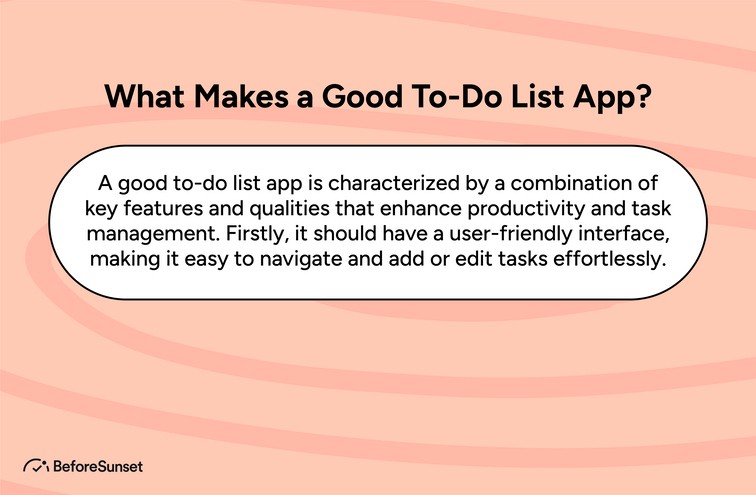
What Makes a Good To-Do List App?
A superb to-do list app needs to be simple to use, very effective, and adaptable to the specific requirements of its users. the following functionalities should be present in the top-notch to-do list apps:
A good task management program should be easy to use, intuitive, and have a plain layout that makes adding, changing, and completing tasks simple.
Task prioritization
A decent to-do list program should enable users to rank their activities according to significance, urgency, or deadline and should also offer a description of what has to be done next.
Multiple ways to organize tasks
To make it simpler to handle many tasks and projects, a good to-do list software should enable users to categorize tasks into projects, categories, or folders.
Reminders for tasks
A decent to-do list program should enable users to create task reminders so they never overlook an important task or forget to meet a deadline.
Adaptation to other tools
A smart to-do list app should interact with other applications and services users use, such as calendars, email, or project management apps, to provide users a complete picture of their activities and schedule.
Customization
A decent to-do list app should let users personalize their experience, including the ability to establish preferences, change the interface's design, and change the settings to suit their specific requirements.
App Privacy
When selecting a to-do list app, app privacy is a crucial consideration. You want to ensure that your tasks, data, and personal information are safeguarded and not sold or shared with outside parties. For your data to be protected from unwanted access, a decent to-do list software should encrypt it both in transit and at rest.
To learn how the to-do list app will use your data and what safeguards it has in place to protect your privacy, see the privacy statement. Verify that the to-do list app does not have the right to sell or use your data for any reason other than to provide the service and that you own and manage your data.
Look into if the to-do list software gives access to your information to other parties and, if so, for what reason. Because data protection regulations differ from region to jurisdiction and you might wish to avoid keeping your data in nations with lax privacy laws, take into account where the to-do list app's servers are located.
Good user interface
A good user interface is important for to-do list software that works well (UI). A good user interface (UI) should be clear, easy to use, and simple to understand. Also, it needs to make it easy for users to create, change, and manage their activities.
Deadline reminders
Deadline reminders are an important feature of a good to-do list app, helping users to stay on top of their tasks and avoid missing important deadlines.
How Do You Get Organized When Overwhelmed at Work?
Getting organized is essential to regaining control and reducing stress when one is feeling overburdened at work. Start by standing back from the issue and evaluating it. Set tasks in order of priority and urgency, concentrating on the most urgent activities first. To make big jobs less intimidating, divide them into smaller, more achievable tasks. To keep track of your tasks and due dates, make a to-do list or use a task management tool.
Establish time constraints and reasonable goals for each assignment. If assistance is required, think about asking your boss or fellow employees, and where practical, distribute work. Reduce interruptions and foster a productive workplace. Last but not least, take care of yourself by taking breaks, using stress-reduction strategies, and keeping a good work-life balance. Keep in mind that organizing is a continuous process, so evaluate your goals frequently and make any adjustments.
Do Daily To Do List Work?
Yes, making a daily to-do list may help you stay focused, organized, and productive. They give you a precise breakdown of what needs to get done on a given day, enabling you to prioritize your work and efficiently use your time and resources.
To-do lists act as a visible reminder of what has to get done, assisting in keeping things from getting lost or forgotten. To-do lists can make bigger projects and goals more achievable and less daunting by dividing them down into smaller, doable tasks.
Additionally, checking items off a to-do list may motivate you and give you a sense of success, increasing your productivity and self-assurance. It assists you in maintaining focus and a sensation of forward motion throughout the day.
The success of daily to-do lists depends on adhering to a few fundamental guidelines. First, resist the urge to overcrowd your list with too many things by making sure it is practical and doable. Set tasks in order of importance and urgency, putting the highest priorities first.
Review and revise your to-do list frequently during the day to reflect shifting priorities or conditions. Be adaptable and willing to make changes as necessary to account for unforeseen duties or disruptions.
Striking a balance between rigidity and flexibility is crucial, too. While to-do lists can help with structure and order, it's also crucial to be flexible and responsive to any new information or requirements that may arise. A to-do list is a tool to keep you organized, but it shouldn't direct your every action. Keep that in mind.
That is why we reccomend using BeforeSunset. BeforeSunset is a great way to keep track of your tasks.

